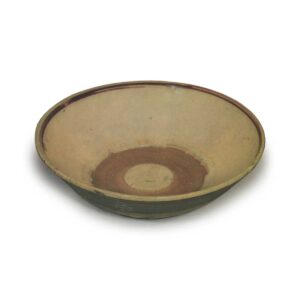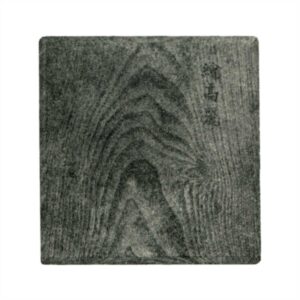

Attachment
Box, mulberry engraved inscription, greenish blue
Clothing: Vertical stripes on pongee ground, mamdo
Wrapping: chintz on red ground
Dimensions
Height: 4.9cm, Bore: 16.3cm, Base diameter: 6.2cm, Height of base: 0.5cm, Weight: 312g
Collection: Nezu Museum, Tokyo
This is a “Kage” teacup in the same style as the previous two works. As mentioned earlier, this type of tea bowl, called “painted Korai,” was made in large quantities at the Gizhou kilns in northern China as a miscellaneous folk artifact. Therefore, they had to be placed in the kiln in layers, and the bottom of the bowls were cut into a large serpentine pattern, the glaze was peeled off, and the base of the upper bowl was placed on top of the bottom. Otherwise, the glaze would melt and adhere the upper and lower bowls together. This snake’s eye, which was created out of sheer necessity, was seen as a pleasing sight by the Japanese tea masters, and is one of the promises of the painted Korai tea bowls.
The edge of the base of this tea bowl shows various views. There is a purplish crescent shape near the edge of the white band, but this is due to the overglaze on top of the broken white makeup, reflecting the color of the clay. The arc line on the underside of the crescent extends to the right, creating a slightly light-colored island on the clay, but this is the result of the rooster makeup remaining on the ground without overglaze.
Box, carved with mulberry tree design, green patina



